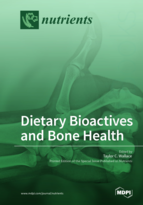Dietary Bioactives and Bone Health
A special issue of Nutrients (ISSN 2072-6643).
Deadline for manuscript submissions: closed (15 April 2017) | Viewed by 126006
Special Issue Editor
Interests: anthocyanins; dietary bioactives; multivitamins; dietary supplements; choline; eggs; calcium; vitamin D; bone health
Special Issues, Collections and Topics in MDPI journals
Special Issue Information
Dear Colleagues,
There is general agreement within the fields of food, nutrition, and medical sciences that an individual’s diet and lifestyle can substantially predispose one to, or protect against osteoporosis, low bone mass, and numerous other age-related bone diseases. Dietary bioactives, found in a wide variety of plant foods, have the great potential to influence bone health. The NIH Office of Dietary Supplements has defined dietary bioactives as “compounds that are constituents in foods and dietary supplements, other than those needed to meet basic human nutritional needs, which are responsible for changes in health status.” These compounds are generally thought to be safe in food at normal consumption levels (e.g., polyphenols in plant foods). Dietary bioactives are currently being assessed for their properties beyond antioxidant capacity, including anti-inflammatory actions. Some compounds or classes of compounds have been reported to enhance bone formation and inhibit bone resorption through their actions on cell signaling pathways that influence osteoblast and osteoclast differentiation.
Emerging scientific evidence is available, including limited dose-response relationships and statistically significant improvements in bone health. However, the literature is in its infancy and well-designed clinical, observational and mechanistic data are needed to better advance our understanding of the importance and mechanisms as to why bioactives may be able to influence long-term bone health outcomes.
Dr. Taylor C. Wallace
Guest Editor
Manuscript Submission Information
Manuscripts should be submitted online at www.mdpi.com by registering and logging in to this website. Once you are registered, click here to go to the submission form. Manuscripts can be submitted until the deadline. All submissions that pass pre-check are peer-reviewed. Accepted papers will be published continuously in the journal (as soon as accepted) and will be listed together on the special issue website. Research articles, review articles as well as short communications are invited. For planned papers, a title and short abstract (about 100 words) can be sent to the Editorial Office for announcement on this website.
Submitted manuscripts should not have been published previously, nor be under consideration for publication elsewhere (except conference proceedings papers). All manuscripts are thoroughly refereed through a single-blind peer-review process. A guide for authors and other relevant information for submission of manuscripts is available on the Instructions for Authors page. Nutrients is an international peer-reviewed open access semimonthly journal published by MDPI.
Please visit the Instructions for Authors page before submitting a manuscript. The Article Processing Charge (APC) for publication in this open access journal is 2900 CHF (Swiss Francs). Submitted papers should be well formatted and use good English. Authors may use MDPI's English editing service prior to publication or during author revisions.
Keywords
- dietary bioactives
- bone
- osteoporosis
- low bone mass
- flavonoids
- polyphenols
- plant foods
- osteoblast
- osteoclast
- antioxidant







